Green Stormwater Infrastructure Effectiveness Monitoring
Here in King County, we know rain is a natural part of life. But hard surfaces like roadways, roofs, and sidewalks interrupt the natural water cycle. These hard surfaces cause rainwater to pool and pick up pollutants that may be present. Polluted rainwater (called stormwater) then enters our rivers, lakes, and streams! To reduce pollution, we need to clean up our stormwater.
One way we do this is by building Green Stormwater Infrastructure (or GSI). GSI mimics natural spaces and filters stormwater through a soil mixture, removing pollutants. GSI often look like tree boxes or planter beds with a cut in the curb that allows stormwater to enter.
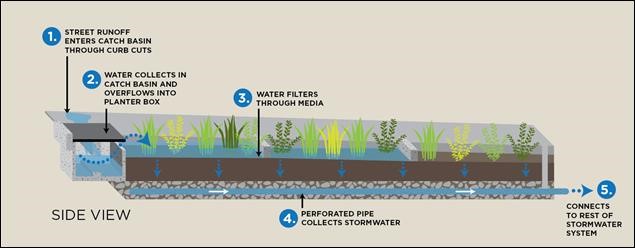
But there are still uncertainties about the effectiveness of GSI facilities. In 2015, King County received funding from Ecology’s Stormwater Action Monitoring Program. The funding supported two projects to study how well GSI installations removed pollutants. The two projects were:
- Stormwater Retrofit Monitoring in the Echo Lake Drainage Basin
- Stormwater retrofit monitoring in Federal Way
We present a summary of the main findings below. More information on project details is lower down on this page.
Main findings
Echo Lake
Bioretention planter boxes reduced most measured pollutants by 81-99% even after 3-5 years. But nutrients were not reduced, and in some cases, increased after treatment. This can be a problem for toxic algae growth in lakes. Also, inlets to the planter boxes are prone to blocking by dirt, leaves and other debris. Regular debris clearing must occur for effective stormwater treatment.
Federal Way
All the study treatments reduced and delayed the timing of peak flows. This should reduce one of the negative impacts of stormwater. But the different treatments had mixed results in reducing the impacts of pollutants. Altogether, the system reduced total suspended solids, organic contaminants, and total metals. But the system increased concentrations of nutrients and dissolved lead. We found that the bioretention facilities were a source of nutrients.
Turbidity improved in a downstream creek, though the data are not yet significant. We did not observe any changes in the creek benthic community, though it is likely too early to detect a change. Long term recovery of the benthic communities in the creek may take more time.
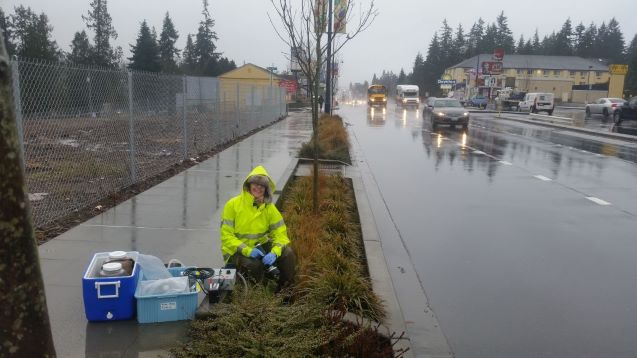
Objectives
The two studies share similar objectives:
- Test the effectiveness of individual stormwater treatment installations at reducing:
- solids
- nutrients
- bacteria
- metals
- select organic contaminants
- toxicity
- stormwater flow (Federal Way retrofit project only)
- Test the effectiveness of entire regional detention systems in the study areas to:
- reduce stormwater flow
- improve water quality.
- Assess changes in stormwater quality in the study systems. Compare historical stormwater quality to current stormwater quality. Compare pre-treatment to post-treatment stormwater quality.
Project specifics
Stormwater Retrofit Monitoring in the Echo Lake Drainage Basin
Echo Lake in Shoreline, Washington
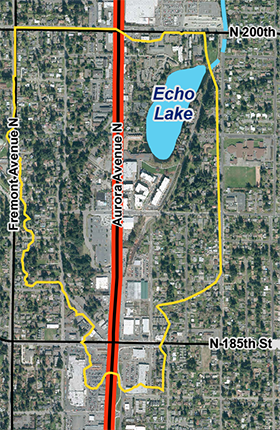
This study tested the effectiveness of stormwater treatment facilities draining into Echo Lake. Echo Lake is a small surface water-fed lake in Shoreline, Washington. It receives stormwater from highway, commercial and residential properties along the Aurora highway. It drains to Lake Ballinger, and is part of the McAleer Creek basin and Lake Washington watershed. The team chose this site because Echo Lake is part of an ongoing long-term monitoring program. The stormwater treatment design allows sampling of stormwater before and after stormwater treatment.
Project documents
Quality Assurance Project Plan
Stormwater retrofit monitoring in Federal Way
South 356th Street Project, Federal Way, Washington
This project tested the effectiveness of different methods for treating stormwater runoff. The project study area was an area in Federal Way, WA that has large amounts of urban development. The area drains into an expanded and retrofitted regional detention facility (RDF). The RDF (known as the South 356th Street Project) combines several treatments. The treatment technologies are two bioretention facilities and a wetland pond complex.
The bioretention facilities treat runoff from a 23-acre commercial drainage basin. The project team used flow meters and auto-samplers at both the inlet and outlet of each facility. This allowed the project team to measure changes in stormwater volume and water quality for each facility.
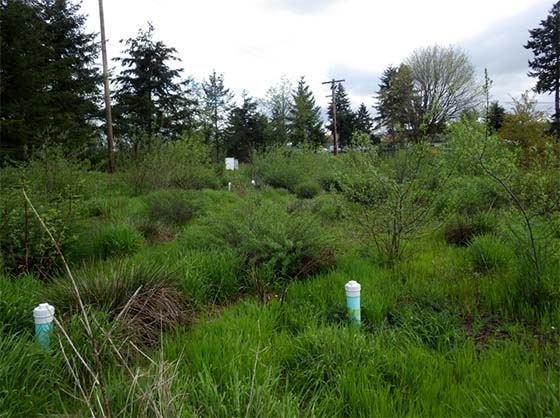
One of the bioretention facilities in the South 356th Street Regional Detention Facility. Federal Way, WA.
The study also tested the effectiveness of an expanded wetland pond complex. This complex treats stormwater from a 189-acre basin. It consists of one wetland built in 1997 and a new one completed in 2014. The purpose of these constructed wetlands was for stormwater detention and treatment.
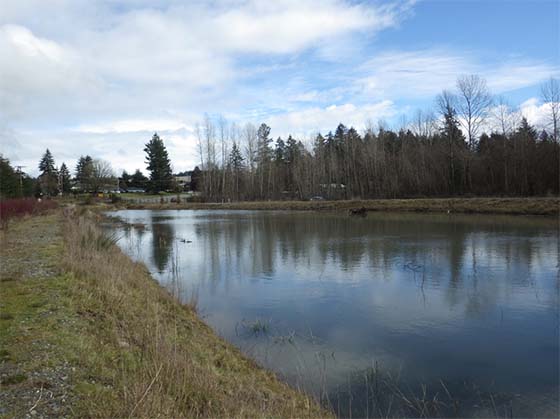
One of the wetlands in the South 356th Street Regional Detention Facility. The wetland combines detention and stormwater treatment. Federal Way, WA.
Besides the shared objectives outline above, this project had another unique objective:
- Observe changes in the macroinvertebrate community and stream temperature in a downstream creek. Determine if any changes correlate with the regional detention facility retrofit and expansion.
Project documents
Quality Assurance Project Plan
Team members
These projects were possible thanks to team members working together. The team members included:
- Staff scientists from the King County Water and Land Resources Division:
- Science and Technical Services Section
- King County Environmental Laboratory
- Personnel from the cities of Federal Way and Shoreline
- Stormwater Action Monitoring staff from Ecology and from Washington State Department of Transportation
- Contract laboratories:
- Pacific Rim Laboratories to analyze samples for polychlorinated biphenyl (PCB) congeners
- Laboratory Data Consultants to provide PCB data validation services.

 Translate
Translate